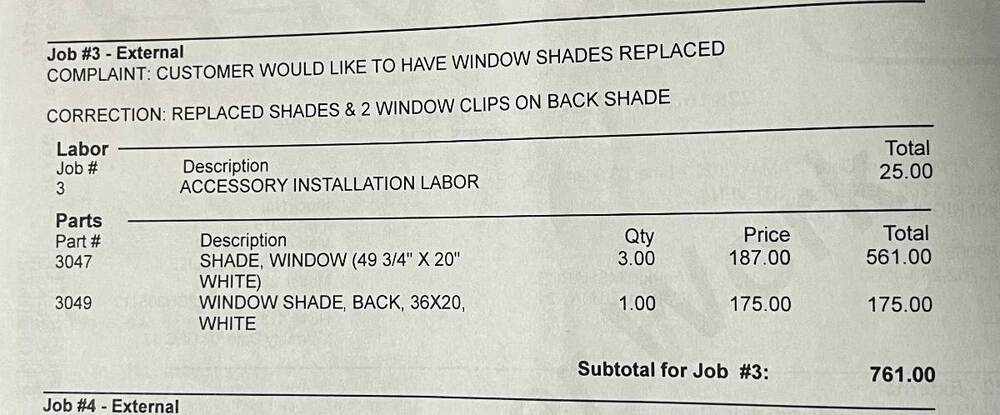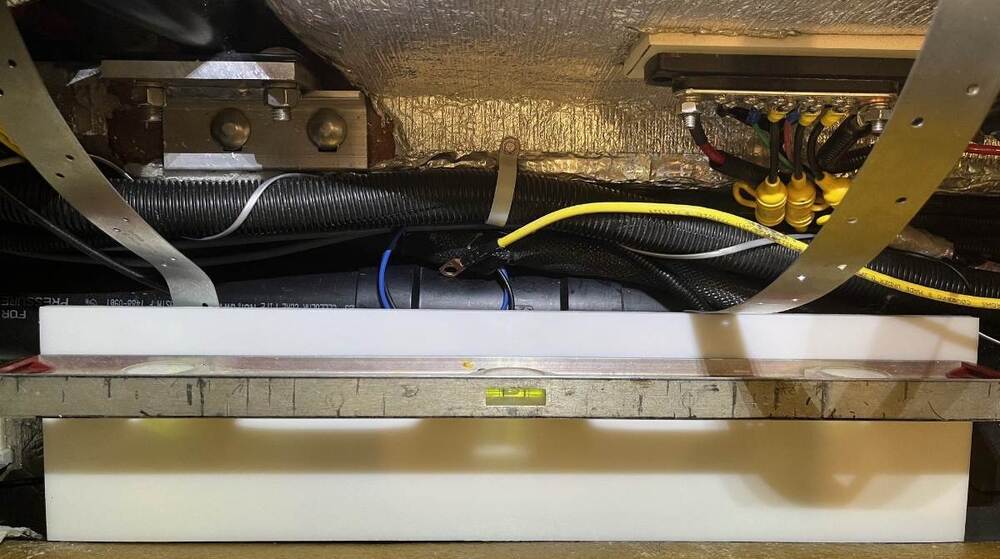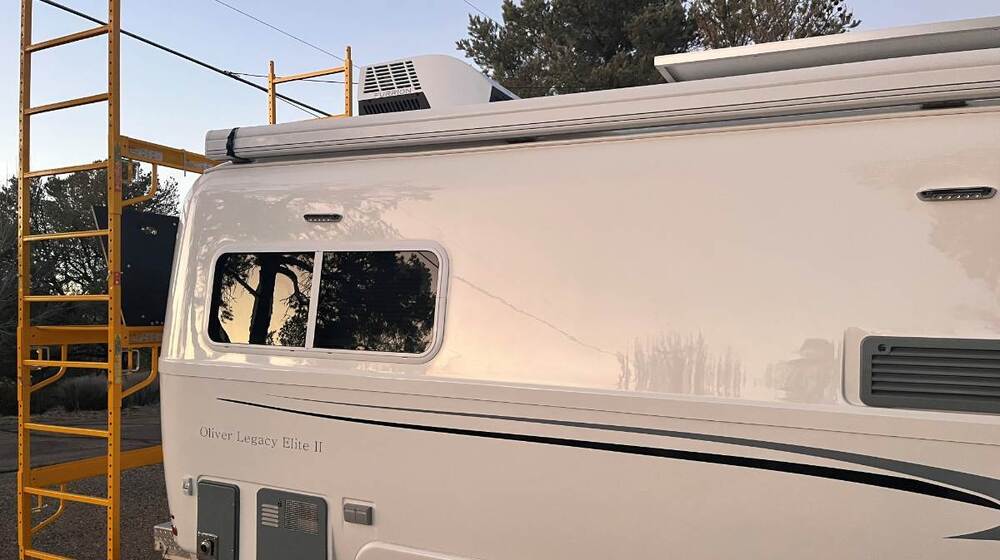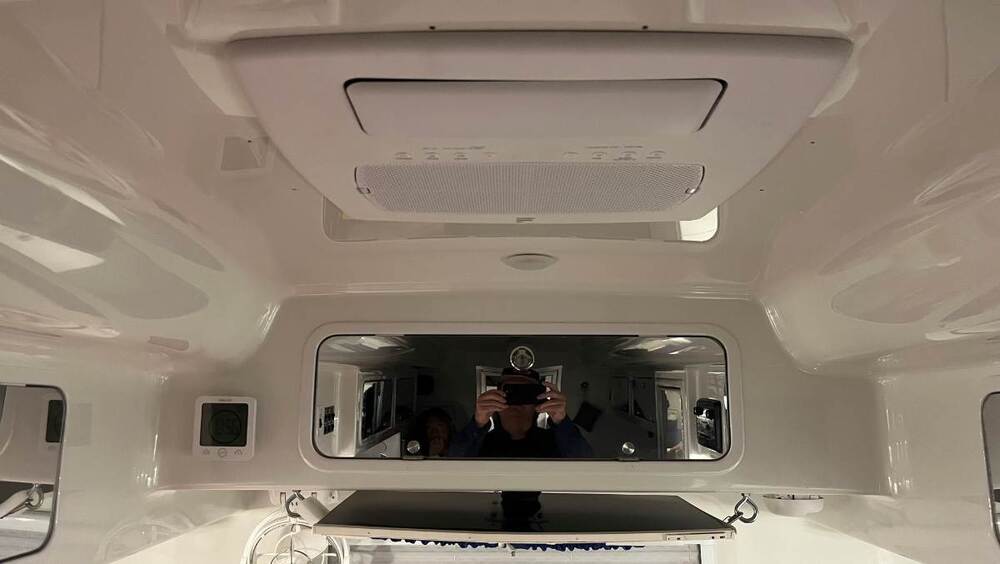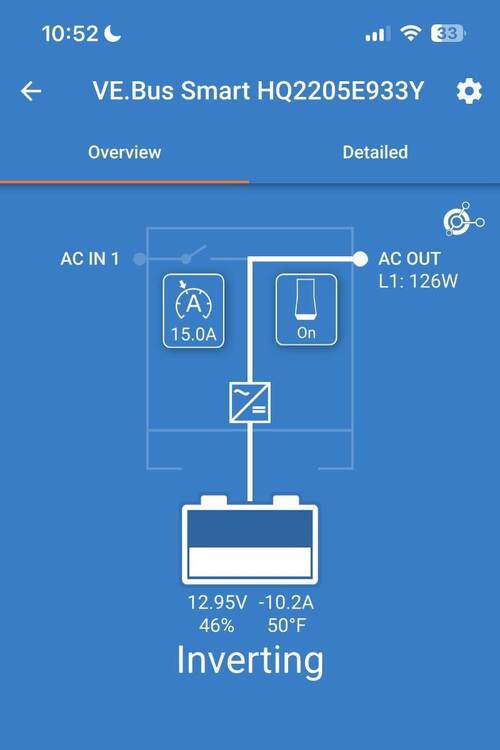-
Posts
3,052 -
Joined
-
Last visited
-
Days Won
218
Everything posted by jd1923
-
We’re leaving Monday, be there in the afternoon! See ya! 😎
-

Furrion Chill Cube – Product Review and Installation
jd1923 replied to jd1923's topic in Ollie Modifications
Thank you Mossey, for this information! I don’t follow tech news much, just research what I need when I’m working on something. I’d hate to be contrary, but I believe this product hit the market last year! It has other brand names like Turbro and Pioneer! It sure looks like these models (in shape and position of condenser fan). This is likely another clone. Too bad, but TBD! 😎 -
Excellent thinking as this is exactly my reasoning! Last week we got down in the low 20s three consecutive nights. If it’s high 20s for a night or two, I’ve learned not to worry. I have a Ruuvi temp sensor in the rear lower basement, under the incoming water lines to keep tabs. We had water in the plumbing, hot water heater, etc. I worked the procedure and we’re good. The other day, since the Oliver was already in our driveway, I worked all 12 steps in <5 min (from memory after years). We’re leaving Monday morning to Quartzsite. Thank goodness I only have to fill the FWT, prime the plumbing, fill the extra 35-gal FWT in the truck and we’re on the road! 😎
-
Yes, good catch Roger, and Mike is correct in his comment! I had many critiques, 2 years ago, when I wrote these instructions and nobody had noticed this before! Just ask @Geronimo John, as I sometimes have a left/right brain thing goin’ on! Directions I’ve written that state drive East as I was thinking West! 🤣 it should read like this: 8) Connect the compressor airline to the Fresh Water inlet (a few seconds is all required). 9) Connect the compressor airline to the City Water inlet (leave it connected) Then yes, work step #10 on City Water. I will revise the instructional thread and I’m also going remove step #13 which I added upon suggestion, but do not believe is necessary. No pink stuff will ever be in my Walmart shopping cart! 😎
-
Yes, load on the inverter creates a voltage drop. You do not see it as much when you have high SOC and ample LiFe PO4 Ah capacity. When I first tried to run A/C on inverter, back when we had lead-acid batteries, the load of the A/C dropped voltage from 12.8 to 12.1V immediately, hence the inverter started reporting warnings. I would drop your low/shut-OFF setting to 11.9V to start. Also, if you going into a cold spell and your Oliver is in storage, why recharge now? If they are disconnected, I would leave them at 50-60%. If you are connected and have some parasitic draw, then getting them closer to 100% SOC does make sense. 😎
-

Day/Night Window Shade Questions
jd1923 replied to rideandfly's topic in Mechanical & Technical Tips
Us too Bill, but thankfully the second owner replaced them May 2021. Total cost was $761 for the set almost 5 years ago (2x as much today?). We also have the bright white frames and I've seen the yellowed ones in older hulls. Sure glad ours are now 5 vs. 10 years old! Two years ago, I removed and hosed them and they've Looked good and worked well since. -

Furrion Chill Cube – Product Review and Installation
jd1923 replied to jd1923's topic in Ollie Modifications
Out here A/C coils fill only with red-oxide Arizona dirt. We lived a few years in South Fla where A/C coils amass all kinds of gunk! -

Furrion Chill Cube – Product Review and Installation
jd1923 replied to jd1923's topic in Ollie Modifications
Gotta love ya, my friend GJ! Next time you're on the mainland, please come to Prescott and together we'll get ol' hull #342 in better shape! 🤣 OK, so as you would, one point at a time... Actually, keep this one your wish list, as the wired thermostat interface is ONLY available on the ducted version which is not optional for our Olivers. My hypothesis: Out here in the SW there would little to NO condensate drip, but some in humid climates. Agreed, but... Looking at the specs I see a 3.25" difference (14.5" - 11.25"). It would be 5" to your low-profile Houghton. I promised @Tideline77 measurements which I took yesterday. My son Adam climbed up the scaffolding and place an 8' 1x3" on top of the A/C unit hanging off to the curbside. I measured the height and did not believe the number, so I measured it in the same way off the streetside, same number! I measured exactly 9' 8.5" on BOTH sides! Let's call it 9' 9" to top of the Chill Cube A/C on hull #113. OTT advertises the Oliver to be 9' 8" top of A/C! How is that? I put an A/C at least 3" taller than OEM! Crazy if this could fit in a garage with a 10 ft door. Chris said, "Who cares how tall it is? It's quiet! 😂 I would think you could simply hose from the rear. The dirt/gunk would fall out into the condensate trough and you would have to remove the cover and hose out the condensate path completely. Two-level scaffolding helps! 😎 All RV A/c manufacturers over-state specs. The Oliver is such a small, well insulated space with an inner hull that does not easily absorb heat. We'll be fine! 😎 I'll measure and provide real numbers this summer! But any Inverter or variable speed system will take near half the power consumption of standard compressor systems, no need for any kind of Soft-Start device. Yes, we like to camp in this range! The Chill Cube also has a Gear feature to gear power down to 75% or 50%! If your worried about high BTU fast cooling OK, but being able to run A/C conservatively, on inverted battery power, for a good amount of time is more our plan. We now have 900 Ah, and with summer temps I'd like to know how much cooling we get per Ah. Would 180 Ah (20% SOC) be enough to keep the Oliver Cabin comfortable all afternoon? If so, we could do that for 3 days knowing on day 4 we'd tow to DC-DC charge or stay a night at a campground and charge back up to 900 Ah! 😎 -
Recently? No, but I lived in Hampton VA, late 70s through the early 80s and knew the area and every road in Hampton Roads/Tidewater! 🤣 We often took the James River Bridge, though a dangerous 5-mile long low flat bridge, yet such a beautiful a drive! On a trip back from Florida we saw a van swerve, hit the guardrail and go in the drink, RIP! If you happen this way, take a short detour and swing by Smithfield, buy a special ham! There's a new road that wasn't there back in the day, I-664 looks like a decent I-64 alternate to get to VA Beach. I have not traveled this route. VA Beach has become a busy place, but walk the boardwalk, nicer along the north end of town, all the way up to Cape Henry. If I was to go all that way AGAIN... I'd have to head south the the Outer Banks and boondock on the shore, or the sound, for sure! 😎
-

Hide Interior Blemishes Using Decorative Emblems
jd1923 replied to jd1923's topic in Mechanical & Technical Tips
Going to a new A/C you have remote control for that. I added a heat-only furnace thermostat, so just ran two wires from under pantry around rear of basement to furnace. All original wiring for Dometic was left in the walls (not that I’d ever use it again)! -

Convert Old Paper Manuals into Digital Format
jd1923 replied to Chris Scarff's topic in General Discussion
That will be two dinners after we install new axles on #110 at half price! 🤣 -

Convert Old Paper Manuals into Digital Format
jd1923 replied to Chris Scarff's topic in General Discussion
Exactly what I have done! 🤣 -

Furrion Chill Cube – Product Review and Installation
jd1923 replied to jd1923's topic in Ollie Modifications
Thanks MosseyI In a way I made in impulsive buy, and maybe could have waited for better pricing. Though I noted list prices of about $1400 for just the main unit (ABD required) and thought the current Amazon prices of $987 ($1,006 today) and $138 ($143 today) for the ADB was good enough (saved $24 plus tax vs. buying today): https://www.amazon.com/dp/B0DM6YMJNY/?th=1 https://www.amazon.com/dp/B0F1464FSX/?th=1 -

Furrion Chill Cube – Product Review and Installation
jd1923 replied to jd1923's topic in Ollie Modifications
GJ, I'm sure you have not had time to study this relatively new model. Even though the video below is 6 months old. I just watched it for the first time two weeks ago... Who knows re the thermistor... I'm not up on the ME as you are. Maybe they have designed and positioned it appropriately, who knows, TBD. 🤣 Re the drain... This model may not need one! Watch the video which I have copied again here... FF to just before 10:00 minutes... -

Local web page to search Oliver forums via Google
jd1923 replied to Chris Scarff's topic in General Discussion
Chris, you are one Rock'in Tech Guy! Works great, love it! 😎 I like how it opens every query in a new tab. Exclude words is a nice feature that I've never been able to use before (wish an Amazon search would return results so clean). Efficient tool (and I say that from years of being website and training content PM and editor). I've used site:craigslist.org <search words> for years to search Craigs nationwide. Awesome, thank you Chris! 😂 -
He’s just a young man, not the battery-god! 🤣 I think making a LiFePO4 investment is important and without internal heaters you’ll be doing work-arounds for as long as you use them, disconnecting them, heat blankets or something. Do it once, do it right! We live in a moderate climate, but over the last few nights with lows to 20F, at 8AM the Ruuvi in our basement at the rear wall measured 27F and the Epoch BMS kept all out battery cells right at 36F. I prefer knowing we can travel any day, at any temp, and use and charge our batteries! 😎 $500 vs. $1200 per 300 Ah is a huge difference though. When we bought our “Essentials” I don’t believe there was an Eco Series available. We purchased Essentails since they were lower cost vs. the Elite Series.
-

What is Towing "Level" and Does It Matter?
jd1923 replied to Sam Heumann's topic in Towing an Oliver
Thanks Ron. BTW, reducing tire pressure will change ride height some due to the weight of the vehicle. Change in diameter of a deflated tire without weight applied would be negligible. Some tires might even be taller when deflated, and with air pressure making them a little wider instead. -

What is Towing "Level" and Does It Matter?
jd1923 replied to Sam Heumann's topic in Towing an Oliver
The AGILIS CROSSCLIMATE LT225/75R16 tires on our Oliver have a spec dia of 29.3". They list the Cooper Discoverer HT3 LT225/75R16 at 29.2". They must have changed the molds, the question in when. I'll measure the ID of the fiberglass spare housing and soon we'll know for hull #113 too. -
Yes, "According to the NEC, the general rule of thumb is that the circuit breaker size should be rated at 125% of the ampacity of the cable and wire for continuous loads." 45A x 1.25 = 56A, round up to 60 as a 50 would be too low. 60A x 1.25 = 75A, but your 70 should be fine at 10A over.
-
Thanks Mike, I’m happy I’m not the only one! Even our OLIVER taillight has a proper seal. As GJ suggested, perhaps we’re Blessed! You know those hull #s 100 +/- are the crème de la crème! 😎
-

What is Towing "Level" and Does It Matter?
jd1923 replied to Sam Heumann's topic in Towing an Oliver
Thanks Ron, I appreciate your effort! Next couple of days I’m working on mud flaps for the Oliver. I’m going to mount mine in front of the stabilizer jacks (others have gone behind). I was thinking the task of custom cutting the mud flaps to fit into the wheel well would be easier with the rear axle wheel off. So while doing so, I’m going to remove the spare and see if my LT225/75R16 tires fit. If yours do and they haven’t changed the hull molds… -
You could use adhesives. OTT is really good at gluing things down, and drilling into fiberglass, but there are better installation methods. I wanted our Victron MP2 mounted on a solid platform and sitting on rubber to reduce vibration and sound, no way screwed to a board glued to the inner hull! 😎 https://olivertraveltrailers.com/forums/topic/10420-off-grid-upgrade-minimal-design-–-victron-multiplus-ii-and-600ah-epoch-lifepo4/
-

What is Towing "Level" and Does It Matter?
jd1923 replied to Sam Heumann's topic in Towing an Oliver
Just topped off the air for our trip to Quartzsite next week. Pressure was low since the weather got cold. 55 PSI with Alcan Springs would be jarring! Now all 4 tires are set right at 46 PSI. I like this number! 😎 -

Furrion Chill Cube – Product Review and Installation
jd1923 replied to jd1923's topic in Ollie Modifications
She's up top and installed, running ever so quietly... I'll write more on the installation soon and total height measurement. It does appear a bit tall, though I took the picture from higher ground. I ran the furnace during the Bears game (love when the Packers get beat, it's so sweet)! Then Chris and I went out to check on the Oliver... The cabin was at 74F and with the Chill Cube set to 60F it cooled quickly (but true testing can not be accomplished during the winter)! When it kicked in, it started drawing only 2A, OMG! We're always on inverted battery power, no shore line. it took a few minutes to ramp up. Highest reading was 18A. The Dometic Penguin II needed over 150A to make that freight train sound and would take 2-3 times as long to cool (how does that work)? I didn't measure total usage this time, but at the high draw of 18A (which sounds crazy, but it would certainly draw more on a hot summer day) I could run this A/C for 50 hours! I'm thinking with 900 Ah LiFePO4 batteries we will be able to run this on at least 3-5 hot afternoons when boondocking, get a hook-up after a week out. Out west you rarely need to run A/C overnight. A/C in the afternoon, furnace by dawn, so yes if they ever sell an upgraded model with heat pump and Bluetooth it would kill the market. Then it settled down at 10A, in AUTO mode the fan was running a low-medium speed (as recorded, run movie). The fan can run even slower/quieter! The huge evaporator fan in the Non-ducted version of the Chill Cube is the secret, and it's what sold me. When turned off the oscillating vent goes back to closed position, love how the air handler hangs <1" below the ceiling! I'm 6'2" and when the vent was full down, standing tall it was still 2-3" above my head. Love how it pushes a lot of air up and down the Oliver hallway but does not blow directly on the beds. Living in the Southwest, and especially after living a few years in South Florida, Summer has become our least favorite season (more so for Chris). I have a feeling that Summers in the Oliver are going to be pretty decent running this A/C unit! 😎 Furrion Chill Cube Running.MOV




